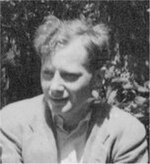J. H. C. Whitehead
| J. H. C. Whitehead | |
|---|---|

John Henry Constantine Whitehead
|
|
| Born |
11 November 1904 Madras (Chennai), India |
| Died | 8 May 1960 (aged 55) Princeton, New Jersey |
| Residence | United Kingdom, U.S. |
| Nationality | British |
| Fields | Mathematics |
| Institutions | Oxford University |
| Alma mater |
Oxford University Princeton University |
| Doctoral advisor | Oswald Veblen |
| Doctoral students | Michael Barratt Ronald Brown Wilfred H. Cockroft Victor K. A. M. Gugenheim Graham Higman Peter Hilton Ioan James Brian Steer |
| Known for |
CW complex Simple homotopy Crossed module Whitehead group Whitehead manifold Whitehead product |
| Notable awards |
Senior Berwick Prize (1948) Fellow of the Royal Society |
John Henry Constantine Whitehead FRS (11 November 1904 – 8 May 1960), known as Henry, was a British mathematician and was one of the founders of homotopy theory. He was born in Chennai (then known as Madras), in India, and died in Princeton, New Jersey, in 1960.
J. H. C. (Henry) Whitehead was the son of the Right Rev. Henry Whitehead, Bishop of Madras, who had studied mathematics at Oxford, and was the nephew of Alfred North Whitehead and Isobel Duncan. He was brought up in Oxford, went to Eton and read mathematics at Balliol College, Oxford, where he co-founded The Invariant Society, the student mathematics society. After a year working as a stockbroker, at Buckmaster & Moore, he started a Ph.D. in 1929 at Princeton University. His thesis, titled The representation of projective spaces, was written under the direction of Oswald Veblen in 1930. While in Princeton, he also worked with Solomon Lefschetz.
He became a fellow of Balliol in 1933. In 1934 he married the concert pianist Barbara Smyth, great-great-granddaughter of Elizabeth Fry and a cousin of Peter Pears; they had two sons. During the Second World War he worked on operations research for submarine warfare. Later, he joined the codebreakers at Bletchley Park, and by 1945 was one of some fifteen mathematicians working in the "Newmanry", a section headed by Max Newman and responsible for breaking a German teleprinter cipher using machine methods. Those methods included the Colossus machines, early digital electronic computers.
...
Wikipedia
